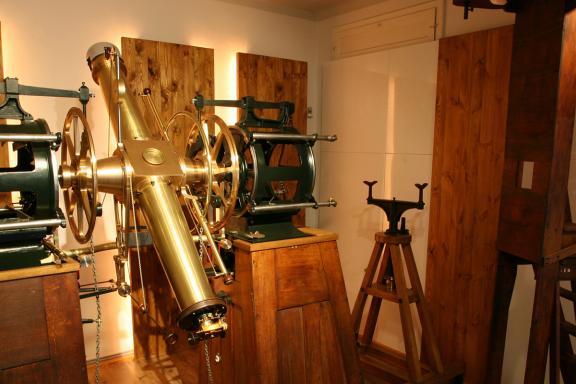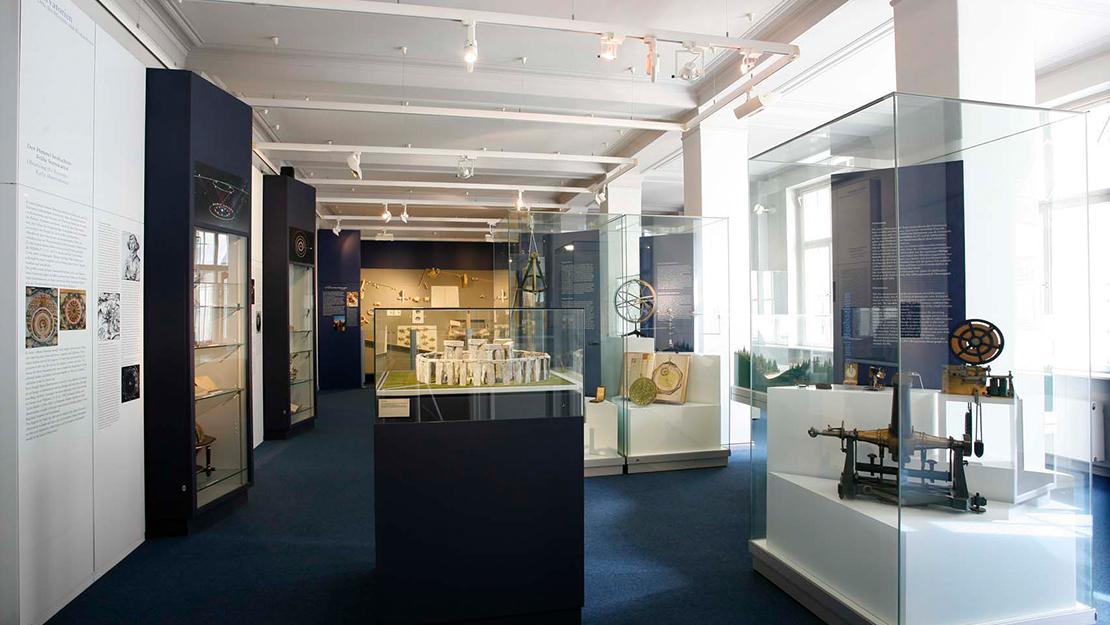
Museum of celestial science
Archenhold-Observatory
Museum of celestial science in the Archenhold-Sternwarte
The first celestial observations date back many millennia, when landmarks were used to try to identify connections between life on Earth and the movements of celestial bodies. From these origins to modern space astronomy, the permanent exhibition traces the development of observatories, including their buildings, instruments and observation techniques – from Stonehenge to radio astronomy and space telescopes.
A variety of smaller historical devices are displayed in the showcases, e.g. sundials, nautical instruments and telescopes through to photometers and spectroscopes. One area displays authentic 1:1 replicas of Renaissance measuring and observation devices, which are also used and demonstrated outdoors at special events.
The impressive large-scale model of the Jantar-Mantar Observatory in Jaipur, India (built 1728-1734), is exemplary for the era of sky observation without telescope. A fully movable model of the Treptow Giant Telescope shows the instrument's range of motion, which is limited only by the horizon. The model of the 100 m radio telescope illustrates the dimensions in which today's large-scale research must work in order to understand ever finer details of the universe.
Opening hours
The Museum of Celestial Science is open during the Archenhold Observatory's event times and, during the Berlin school holidays, additionally from Monday to Thursday 10 am to 2 pm and on Friday from 12 noon to 10 pm.
Admission to the museum is free of charge.
The museum is wheelchair-accessible.

Themes of the permanent exhibition
Observing and Measuring
The exhibition area »Observing and Measuring« uses interactive experiments and numerous historical and modern objects – globes, instruments and clocks – to answer astronomers' latest questions about the universe: how did the Moon and the Earth come into being? Why does the moon have such large craters on its surface? How heavy would we be on Mars or Jupiter? How do black holes form in space?

Messstation Himmel – Arbeitsplatz Erde
The exhibition area »Messstation Himmel – Arbeitsplatz Erde« illuminates an important topic of classical astronomy: the determination of location with the help of the stars and the precise measurement of the Earth. The display cases show sextants and clocks, but also calibration measures and documents on national triangulation. A universal instrument for the astronomical determination of first-order measuring points, made in 1860 by Pistor & Martin in Berlin, is particularly impressive.

The Astronomiers' Room
The »Astronomers' Room« contains an elaborately restored Repsold meridian circle which dates back to 1891 and comes from the Munich-Bogenhausen Observatory. Meridian circles are precision telescopes that were the main instrument of positional astronomy from the first half of the 19th century until well into the 20th century.
Other tools and aids illustrate what it meant to take an astronomical measurement back then. These include a Riefler tank clock, which, with a rate consistency of 1/100 s/month, formed the last generation of mechanical precision clocks before the introduction of quartz and atomic clocks.

The Solar System
The most eye-catching part of the permanent exhibition is a 283.5 kg piece of debris from the meteorite that formed the Barringer crater in Arizona. The piece is made entirely of nickel iron and visitors can even touch it. Models, displays and texts are used to provide up-to-date knowledge about the sun, planets and dwarf planets, meteors and comets. A key detail is the telescope with which the amateur astronomer Karl Ludwig Hencke discovered the dwarf planet »Astraea« in 1845.

The History of the Archenhold-Sternwarte
In addition, display boards with photos and texts provide an overview of the history of the Archenhold-Sternwarte from its beginnings to the present day. Through a chronological and thematic presentation, political and cultural connections also become clear. The most important stations of the eventful history, such as Albert Einstein's visit, are illuminated by information boards with interesting pictures and documents.

Experimental Laboratory
In the experimental laboratory, some experiments on »Astronomy Beyond Light« are carried out. The experimental setups include a counter telescope, a spark chamber and a magnetometer, used to measure and detect cosmic rays. The spark chamber, for example, is a particle detector and is used to detect relativistic effects, among other things. Its use is demonstrated at special events.